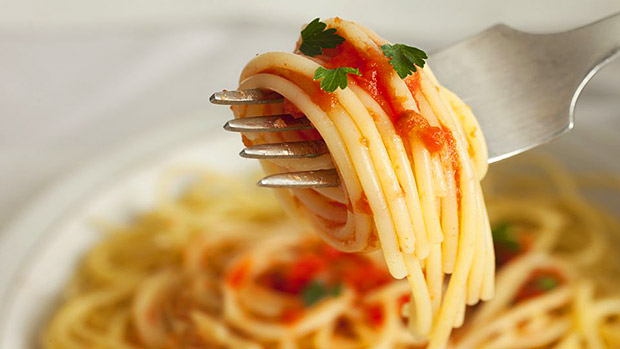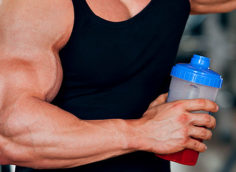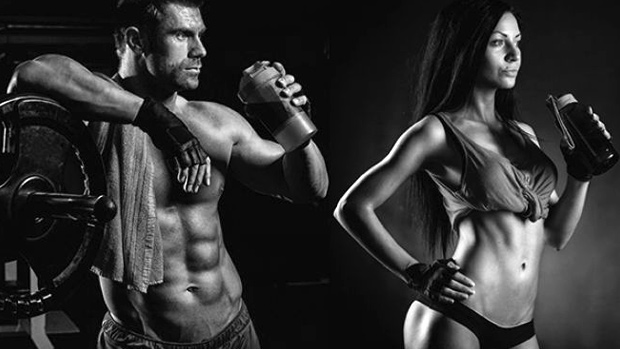Bring on the grub!
It's the battle cry of any bodybuilder worth his salt, or should I say, protein. Or maybe his carbs. Anyhow, massive eating is one of our defining characteristics.
But are we killing ourselves with all that beef, tuna, bread, high-calorie drink – food in general? Well, ultimately, yes. The risks are protracted but they're real and the price is pretty high. It's hard to argue the relationship between life-long food intake and hastened mortality.
There are a number of reasons for it: elevated metabolism, low-grade inflammation, organ stress, and just "stuff" clogging-up our systems. To paraphrase Dr. Jeff Volek, "All these data make eating itself look pretty unhealthy."(16) How unhealthy? So much so that the antithesis of massive eating, severe kcal restriction is the only environmental stimulus (or lack thereof) that's more or less proven to increase lifespan.
One needs only to watch the Discovery channel to see how researchers increase the lifespan of lab critters by withholding food from them. So where does that leave guys who regularly consume 3000-5000 or more calories each day?
Presumably it gets them moved up a few pages in the Reaper's schedule book.
Yet the fact remains: to grow big one must eat big. Adding or even maintaining much-coveted muscle mass takes serious – at times even forced – effort at the table. It's even been called "the battle of the knife and fork." It's hard, strictly scheduled work but it can admittedly be fun, too.
I once had a mentor who called off-season bodybuilding the "lazy man's way to eat whatever he wants." Although there's nothing lazy about doing volume work with 400 pound squats, I can see his point. The association between muscle mass and calorie expenditure is clear.(6) And it's not just higher resting metabolic rate (RMR) that's affected; everything a big person does requires more energy just to move around all that additional size.
Anyone who's forgotten to reprogram a treadmill after a small woman has used it knows how disappointingly few kcal are expended at lower body weights. That LED console mocks your 60 minute effort with a feeble readout of perhaps 200 spent calories. (Note: putting your fist through it won't correct these numbers.)
All that energy expended by larger hombres requires oxygen, and that in itself has its problems. As John Berardi and I mentioned in "Getting Rusty," there's an obligatory mis-processing of O2 approximated at 1-2% during aerobic metabolism. Resultant free radicals can damage cell membranes and our very DNA... certainly not conducive to longevity. Typically we think of fast metabolic rates and higher thyroid or adrenalin levels as good. They're conducive to fat loss, wakefulness, and a sense of energy. But it's also worthy to mention that those who run through life reach its end sooner than those who stroll.
So again we waffle between longevity and our bodybuilding goals. The rigors of physique enhancement call for fat burning and that means taking life at an aggressive pace. At 65-70% of total energy expenditure, RMR is a huge part of the equation and slowing it with severe calorie restriction is not an option. Nor is avoidance of elevated metabolism through the shunning of exercise and thermogenic substances/ foods.
Okay, so we're going to stick to our (big) guns and continue on with aggressive eating and pursuit of a speedy metabolism. As defining characteristics of the physique athlete, how can we not? These things set us apart from meek average folk, fuel our brutal workouts, provide building blocks, and are indeed usually damn fun.
But the Reaper has still more reasons to pose as our helpful waiter, encouraging those few extra servings. I'm talking about the substrates themselves. There are data out there – although debatable – that protein, particularly animal protein, is detrimental to our disease risk. Much of this research has been done in animals, however, and I would argue that it extrapolates poorly to healthy men. (For example: Imagine stuffing a little [herbivorous] rabbit's mouth with bloody chunks of meat and then having the gall to be shocked at his abnormal cholesterol profile. That's pretty much how some of the "protein paranoia" started.)
Nonetheless, one can find evidence that high protein intakes alter cardiac markers for the worse (4), may reduce muscle insulin resistance (14), increase calcium losses (3), and ultimately require more renal filtration – leading to more "stress" on the kidneys.(12,15) This is NOT to say that protein is dangerous, just that it induces a bit of "wear and tear" like other substrates do.
Similarly, total fat intake (all types combined) is also related to cancer and heart disease in general.(8) And sugar, fat and sodium consumption across the years have been associated with poor glucose tolerance and glycosylation of our bodies.(11) Nobody wants their tissues overly "gummed up" with sugar residues. You see, even the "good stuff" in the food we eat comes with a price – over time. Between oxidative stress and now glycosylation, we've already touched upon two major theories behind aging.
Then of course, we have food contamination – an ever-growing environmental problem. Mercury and phytoestrogens come immediately to mind. It stands to reason that the more we eat, the more of everything enters our systems. Perhaps we've become prone to focus upon all the good stuff that we massive eaters put into our bodies and have forgotten the unassuming micro-contaminants that tag along.
Are we screwed then? Yes and no. Time is against us all. As Mick Jagger put so well: "What a drag it is getting old." And yet there are certainly some things we can do as food-o-phyllic bodybuilders to both 1.) get large and 2.) postpone the swing of the sickle. Clearly health and well-being are improved by physical activity and a proper diet (1) so let's look at several related factors.
So What Can Be Done?
For those with no contraindications who'd like to add nutrient density to their diet and maximize longevity in the face of massive eating and self-abusive workouts...
Consume antioxidant foods and perhaps even supplements – particularly if you don't get enough fruits and vegetables (which applies to almost everyone). Aside from the health benefits mentioned, there's some evidence that oxidative stress supercedes an athlete's ability to endogenously, naturally adapt. (10)
Examples of antioxidant foods include: berries, grapes, citrus, prunes, teas, vitamins C and E, olive oil, whey protein, etc.
Consume whole foods for their beneficial phytochemical content; the combinations and ratios therein have yet to be mimicked by technology.
These include: cruciferous vegetables like broccoli, cabbage and cauliflower (containing indoles, etc.), whole grains (can contain isoprenoids), garlic (contains allicin), flax (contains lignans), teas (contain flavanoids like tannins), colorful vegetables (contain various carotenoids), nuts (contain resveratrol), etc.
Note that some foods, e.g. soy, contain phytoestrogens that some bodybuilding men may wish to avoid. (Soy is different from flax.)
Manage insulin and glucose levels throughout the day.
Frequent smaller meals are helpful. (7)
A non-exercise-related carbohydrate to protein ratio of 1.4:1 appears beneficial, at least when dieting. (9)
Reduce carbohydrate load in the evenings (for more information, read Temporal Nutrition).
Consume soluble fiber like that found in oat bran, apples, dried beans, etc.
Vitamins C and E can reduce glycosylation of tissues. (2,5,13)
Engage in resistance training and aerobic activity.
Improve the fat profile of the diet (this is huge!).
Reduce saturated fat intake to 10% or less of calories (some saturates like palmitic acid appear worse than others, like stearic acid).
Increase monounsaturated fats (e.g. olive oil).
Reduce omega-6 fat intake to about 3-4% of the diet (based upon kcal).
Increase omega-3 fat intake to 1-2% of dietary kcal.
So you see, some things can be done to reduce the risks of chronic disease and premature "aging" (although, of course nothing can stop or reverse aging per se). Interestingly, many of the lifestyle factors that bodybuilders employ for physique enhancement are already on our list. That is to say, they already address longevity as well. Aside from a general need for more of everything as training loads and body size creep up, bodybuilding isn't always hard on one's health. Nutrient choices and regular (sane) exercise may help offset our big calorie intakes and fast metabolisms.
In the end it looks like there may still be a trade off – quality of life vs. quantity of life. Large kcal intakes and revving metabolic rates are necessary – even welcome – "evils" to serious bodybuilders. Being big, strong, capable and confident is worth it for many of us. Continuing the battle of the knife and fork (keeping the food flowing in our quest for muscle growth) isn't unlike pushing heavy weights, which could eventually lead to accelerated osteoarthritis and injury; raising T levels, which can worsen cholesterol profiles in some cases; or many of the other extreme things bodybuilders do in the pursuit of their "calling." Heck, just being a man leaves you with a shorter lifespan.
Your choice of whether or not to be a big eatin' bodybuilder – which itself is to be a little extreme – is an important one. Your very lifespan may be compromised. We might say that the "steaks are high." So unless you're willing to accept an exceptionally long life of getting sand kicked in your face as you nibble low-cal foods, fear not the fork!
References
1. Centers for Disease Control and Prevention, National Center for Chronic Disease and Health Promotion. Physical activity and health: a report of the Surgeon General. Washington, DC: US Government Printing Office, 1996.
2. Ceriello, A., et al. (1988). A preliminary note on inhibiting effect of alpha-tocopherol (vit. E) on protein glycation. Diabete Metab 14(1):40-42.
3. Cloutier, G. and Barr, S. (2003). Protein and bone health: literature review and counseling implications. Can J Diet Pract Res 64(1):5-11.
4. Fleming, R. (2000). The effect of high-protein diets on coronary blood flow. Angiology 51(10):817-26.
5. Head, K. (1999). Natural therapies for ocular disorders, part one: diseases of the retina. Altern Med Rev 4(5):342-359.
6. Illner, K., et al. (2000). Metabolically active components of fat free mass and resting energy expenditure in non-obese adults. Am J Physiol Endocrinol Metab 278(2): E308-E315.
7. Jenkins, D., et al. (1989). Nibbling versus gorging: metabolic advantages of increased meal frequency. N Engl J Med 321(14): 929-934.
8. Kuller, L. Dietary fat and chronic diseases: epidemiologic review, J Am Diet Assoc 97: S9-S15, 1997.
9. Layman, D., et al. (2003). A reduced ratio of dietary carbohydrate to protein improves body composition and blood lipid profiles during weight loss in adult women. J Nutr 133(2): 411-417.
10. Lowery, L., et al. (2001). Antioxidants. In: Sports Supplements. Lippincott, Williams and Wilkins; Antonio and Stout Eds.: Philadelphia, PA.
11. Preuss, H. (1997). Effects of glucose/insulin perturbations on aging and chronic disorders of aging: the evidence. J Am Coll Nutr 16(5):397-403.
12. Pundziene, B. (2002). The value and adaptability of glomerular filtration rate and reserve test (review of the literature) Medicina (Kaunas) 38(1):6-15.
13. Qian, P., et al. (2000). Effects of vitamin E and vitamin C on nonenzymatic glycation and peroxidation in experimental diabetic rats. Wei Sheng Yan Jiu 29(4):226-228.
14. Tremblay, F. and Marette, A. (2001). Amino acids and insulin signaling via the mTOR/p70 S6 kinase pathway: A negative feedback mechanism leading to insulin resistance in skeletal muscle cells. J Biol Chem 2001 Oct 12;276(41):38052-38060.
15. Vogt, L., et al.(2002). Renoprotection: a matter of blood pressure reduction or agent-characteristics? J Am Soc Nephrol 13 Suppl 3:S202-S207.
16. Volek, J. (2003). Ketogenic diets, weight loss and exercise. SCAN Symposium, Chicago, IL




